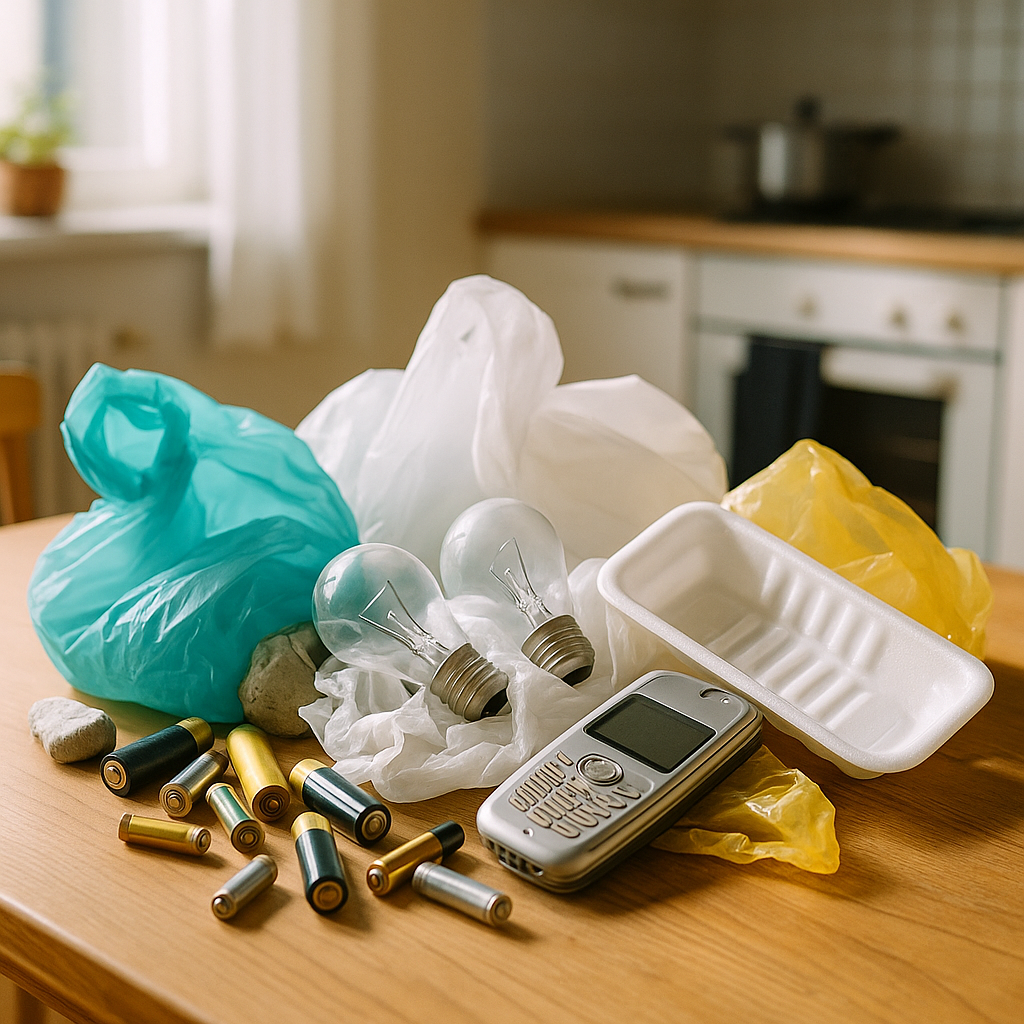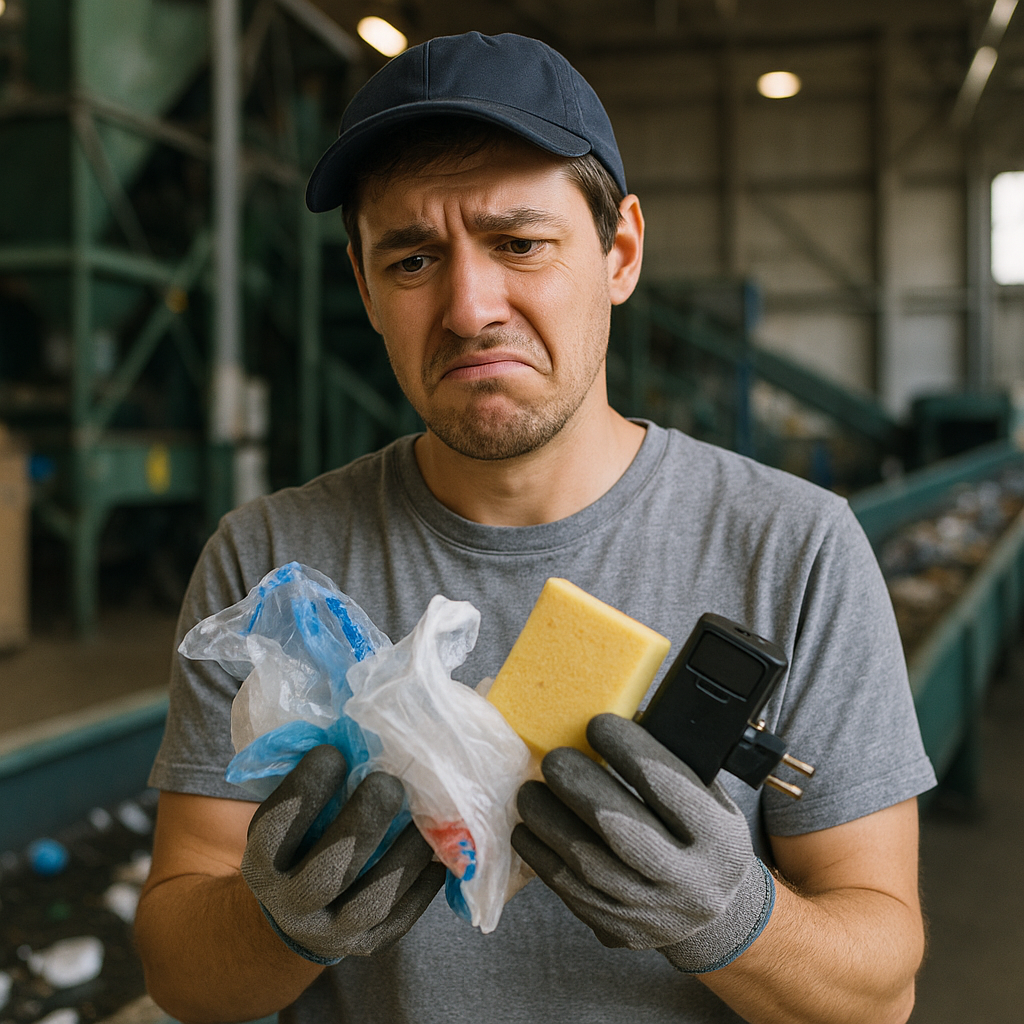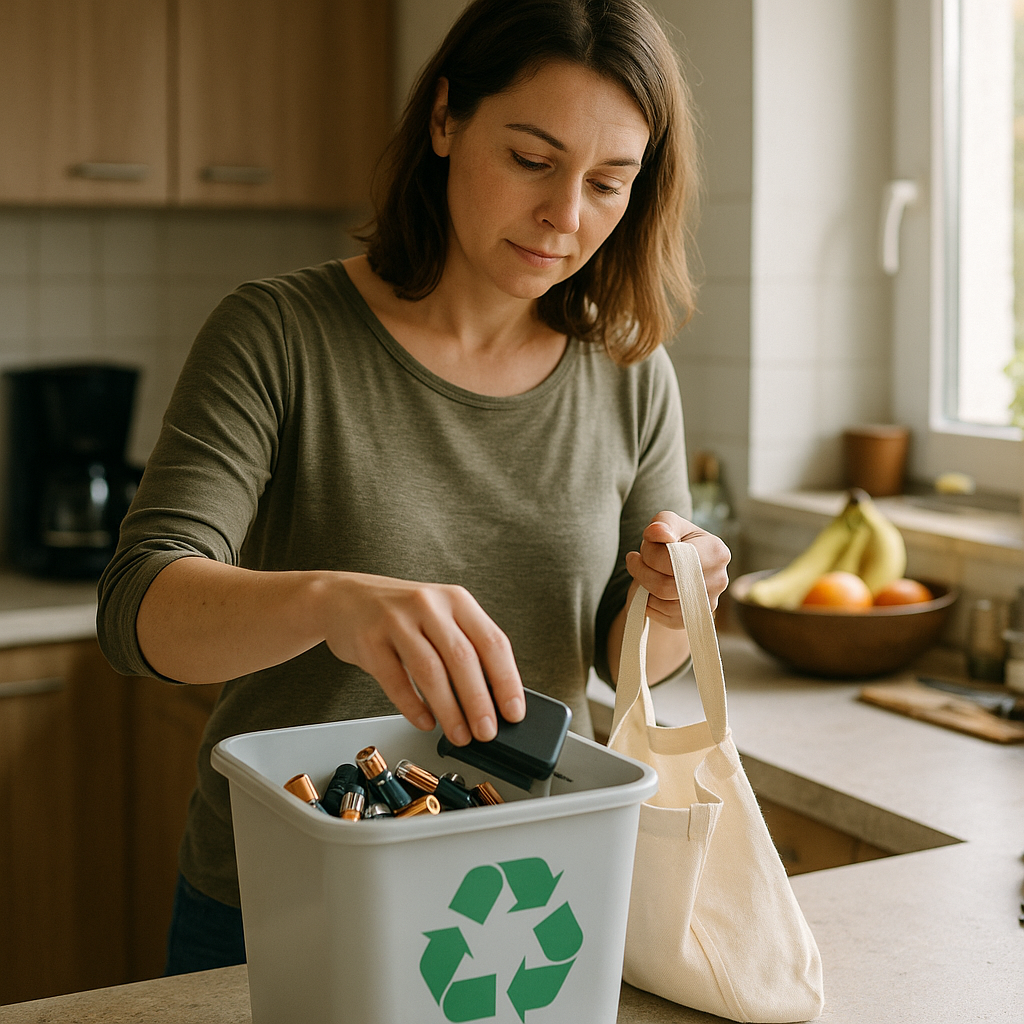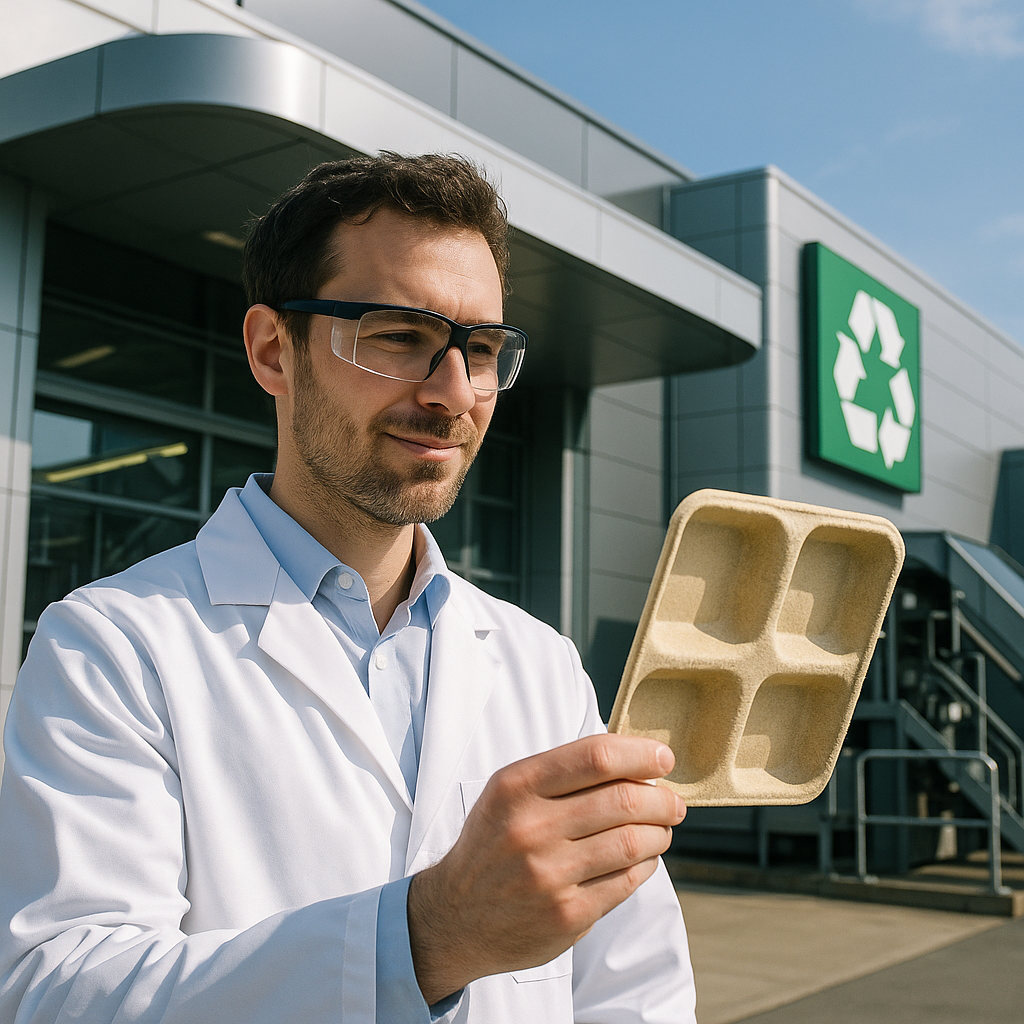5901 Botham Jean Blvd, Dallas, TX 75215
Discover the Materials that are Challenging to Recycle
August 26, 2025Hard-to-recycle materials are items that cannot be processed through standard curbside recycling programs. These materials pose significant challenges for traditional recycling facilities due to their composition, contamination levels, or structural complexity. They often require specialized equipment and processes, which most municipal recycling programs do not provide.
Many everyday items fall into this category. Mixed-material products like coffee cups with plastic linings or packaging that combines different materials create recycling obstacles. Composite materials such as fiberglass, particleboard, and certain plastic-metal combinations also resist standard recycling methods, as they cannot be easily separated into their components through conventional recycling systems.
Certain plastics present particular challenges. Plastic bags, straws, and polystyrene foam (Styrofoam) containers are notoriously difficult to recycle. Similarly, specialty glass products like mirrors, window glass, and heat-resistant cookware differ chemically from standard glass bottles and cannot be processed alongside them. When these materials enter regular recycling streams, they can contaminate entire batches of otherwise recyclable materials, reducing efficiency and increasing costs.
What Are the Most Common Hard to Recycle Items?

While recycling is crucial for waste management and environmental conservation, not all materials are easily processed through standard systems. Some items are particularly challenging due to their composition, contamination issues, or processing limitations. Understanding these difficulties helps municipalities and businesses create more effective waste diversion strategies.
Mixed Material Products
Products made from multiple materials pose significant recycling challenges. These items require component separation before recycling, making the process costly and time-consuming.
Takeaway coffee cups are a prime example. Though they appear to be made of paper, they contain a thin plastic film for waterproofing. This combination makes them nearly impossible to recycle through standard methods, leading most cups to end up in landfills.
Similarly, milk and juice cartons contain paper, plastic, and sometimes aluminum, complicating recycling due to their complex construction.
Composite Materials
Unlike mixed-material products, composite materials integrate multiple resources at a fundamental level, making separation virtually impossible.
Particleboard combines woodchips with synthetic resin, which cannot be effectively separated, limiting recycling options. Most discarded particleboard ends up in landfills.
Fiberglass, used in insulation, boats, and automotive parts, merges plastic and glass fibers. This durable material presents serious recycling challenges and can pose health hazards when improperly disposed.
Problematic Plastics
Not all plastics are equally recyclable. Certain types consistently create issues in recycling systems.
Polystyrene, or Styrofoam, is particularly problematic. Although technically recyclable, it is rarely accepted in curbside programs due to transportation costs and contamination with food waste.
Plastic bags and films often tangle sorting equipment, causing frequent shutdowns for cleaning. Some facilities must halt operations almost every two hours to remove these materials.
| Resin Code | Plastic Type | Common Products | Recyclability |
|---|---|---|---|
| #1 | PET (Polyethylene Terephthalate) | Soda bottles, juice containers, fruit clamshells | Widely recyclable |
| #2 | HDPE (High-Density Polyethylene) | Milk jugs, detergent bottles, shampoo bottles | Widely recyclable |
| #3 | PVC (Polyvinyl Chloride) | Plumbing pipes, window frames, toys | Difficult; limited recyclability |
| #4 | LDPE (Low-Density Polyethylene) | Plastic bags, bread bags, dry-cleaner bags | Not accepted in curbside programs |
| #5 | PP (Polypropylene) | Straws, yogurt containers, takeout containers | Increasingly accepted |
| #6 | PS (Polystyrene) | Styrofoam, packaging peanuts, disposable cups | Not commonly recycled |
| #7 | Other/Miscellaneous | Bioplastics, acrylic, nylon | Rarely recycled |
Contaminated Products
Food contamination can make otherwise recyclable items unsuitable. Pizza boxes with grease, used paper napkins, and containers with residue all fall into this category.
The issue isn’t just aesthetic—contaminants can ruin entire batches of recyclable materials. Oil and food residue compromise the quality of recycled paper and cardboard, potentially wasting entire loads.
Certain Glass Products
Glass bottles and jars are generally recyclable, but other glass items are not. Heat-resistant glass like Pyrex, drinking glasses, and window glass have different melting points, making them incompatible with standard recycling.
Mirrors add to the challenge due to their reflective backing, which contains metals that contaminate the recycling stream.
Electronic Waste
Electronics contain valuable metals and hazardous components, making proper recycling essential yet complex. Devices like smartphones and computers require specialized handling to recover valuable materials while containing harmful substances.
Batteries and lightbulbs also pose challenges. Both contain materials harmful to the environment if improperly disposed of and require unique recycling processes.
The complexity of e-waste recycling has led many communities to establish dedicated collection programs rather than relying on standard recycling streams.
Understanding these recycling challenges helps consumers make informed disposal decisions. When recycling isn’t feasible, reducing consumption of hard-to-recycle items becomes crucial for environmental protection.
Why Are These Materials Difficult to Recycle?

Recycling isn’t as straightforward as tossing items into a blue bin. Several barriers make certain materials especially challenging to process. Understanding these challenges helps explain why recycling rates remain lower than ideal despite our efforts.
Material Separation Challenges
Mixed material products create significant recycling obstacles. Consider a coffee cup—appearing to be paper but lined with a thin plastic film for waterproofing. These different components must be separated for efficient recycling. Many facilities, however, lack the technology or economic incentive to perform this separation.
Coffee cups, padded envelopes, and cartons are examples where separation is technically possible but rarely cost-effective in real-world recycling systems. When materials remain mixed, they contaminate each other and reduce the recyclate’s value and usefulness.
The economics rarely support intensive manual separation. Facilities must process large volumes quickly, making it impractical to disassemble complex items with multiple materials.
Composite Materials: Permanently Bonded
While mixed materials are difficult to separate, composite materials present an even greater challenge. Composites merge different resources at a molecular level, making separation nearly impossible.
Fiberglass exemplifies this issue. Made by combining plastic and glass, fiberglass is used for insulation, boats, and various construction applications. The intimate bonding of these materials makes recycling extremely difficult, forcing most fiberglass to be landfilled at the end of its useful life.
Particleboard presents similar issues. Wood chips bound together with synthetic resin create a material that cannot be separated back into its original components. While some particleboard can be recycled into new composite products, its tendency to crumble makes this challenging.
Problematic Plastics
Plastics vary significantly in recyclability. Thin plastic films and bags, though technically recyclable, cause major operational problems in standard recycling facilities. Their flexibility allows them to wrap around sorting machinery, causing jams and shutdowns that waste time and money.
Another issue is the vast diversity of plastic types. Of the seven common plastic categories, only two are widely recycled through curbside programs. Others, like polystyrene (often called Styrofoam), are theoretically recyclable but rarely accepted because the economics and logistics are unfavorable.
PVC presents unique challenges as well. When accidentally mixed with PET (used for water bottles), PVC releases hydrochloric acid gas during processing, damaging equipment and degrading the quality of recycled PET.
Contamination Issues
Contamination remains one of recycling’s most persistent challenges. Food residue on containers can ruin entire batches of otherwise recyclable materials. For example, a pizza box soiled with grease cannot be recycled as oils interfere with the paper recycling process.
Even small amounts of the wrong materials can contaminate large batches, which is why proper cleaning of recyclables before disposal is essential. Shampoo bottles, food containers, and other packaging should be thoroughly rinsed to remove residues that could contaminate the recycling stream.
Hazardous substances also pose contamination risks. Products containing chemicals, paints, or other harmful materials require special handling and shouldn’t enter the standard recycling stream.
Consumers often place non-recyclable items in recycling bins, hoping they will be processed. Unfortunately, this well-intentioned practice actually increases contamination and processing costs.
Recognizing these challenges doesn’t mean we should abandon recycling efforts. Instead, it underscores the importance of proper sorting, rinsing containers, and following local recycling guidelines. It also highlights why reduction and reuse often take precedence in waste management over recycling alone.
| Material Type | Challenges |
|---|---|
| Mixed Material Products | Require separation; costly and time-consuming to process |
| Composite Materials | Materials are merged at a fundamental level; nearly impossible to separate |
| Problematic Plastics | Operational issues; diverse types, only two recycled in curbside programs |
| Contaminated Products | Food residue and oil contamination can ruin batches |
| Certain Glass Products | Different melting points; reflective backing causes contamination |
| Electronic Waste | Complexities in recovering valuable and hazardous materials |
What Solutions Exist for Hard to Recycle Materials?

Addressing hard-to-recycle materials demands innovative approaches from multiple stakeholders. Communities nationwide are implementing effective solutions to divert challenging waste streams from landfills, showcasing promising advancements in waste management.
Special Collection Events
Many municipalities now organize dedicated collection events for materials that cannot go in regular recycling bins. These events offer residents proper disposal options for electronics, polystyrene foam, and other challenging items.
In Kitsap County, for example, officials coordinate foam collection events where residents can drop off expanded polystyrene (EPS) for proper processing. Although these events face financial challenges, with costs increasing fiftyfold since 2017, they provide a vital service for materials that would otherwise end up in landfills.
Electronic waste collection events have become increasingly common as communities recognize the environmental hazards of improper disposal. These events typically accept anything with a plug, from computers and phones to projectors and batteries.
Specialty Recycling Companies
Private companies have emerged to address gaps in municipal recycling programs. Specialty recyclers like Great Lakes Electronics Corporation manage specific waste streams with dedicated equipment and expertise.
These companies often provide comprehensive services, including data destruction for electronics, asset management tracking, and environmentally responsible material processing. Their specialized equipment can break down challenging materials like expanded polystyrene into reusable pellets for manufacturing new products.
For foam materials specifically, some recyclers use densifiers to compress foam, removing air to create compact blocks that can be transported more efficiently. Companies like StyroRecycle in Kent and DTG Recycle in Tacoma offer drop-off recycling for foam materials.
Subscription-based services like Ridwell offer doorstep collection of hard-to-recycle items, including expanded polystyrene, within their service areas. These convenient options help overcome transportation barriers for consumers.
| Option | Description | Examples | Special Features |
| Special Collection Events | Dedicated collection for non-standard recyclables | Electronics, polystyrene foam | Reduces landfill diversion |
| Specialty Recycling Companies | Private entities handling specific waste with specialized equipment | Expanded polystyrene, electronics | Data destruction, asset management tracking |
| Mail-in Recycling Programs | Pioneered by companies like TerraCycle offering mail-in options | Toothbrushes, coffee capsules | Diverts items from landfills |
| Manufacturer Initiatives | Redesigning products for recyclability | Electronics, packaging | Recover valuable materials |
| Take-Back Programs | Retailers and brands recycle products post-consumer | Electronics, clothing, batteries | Convenient for consumers, aligns with brand loyalty |
Mail-in Recycling Programs
TerraCycle has pioneered mail-in recycling for items that traditional programs cannot handle. Their specialized programs accept everything from toothbrushes to coffee capsules, helping divert these materials from landfills.
The EPA recommends resources like Call2Recycle, Earth911, and Greener Gadgets to help consumers find recycling options for electronics and other challenging materials. These directories connect people with appropriate recycling channels based on their location and specific items.
Manufacturer Initiatives
Recognizing their responsibility in the product lifecycle, many manufacturers are redesigning packaging and products for improved recyclability. This trend towards “design for recycling” addresses waste challenges at their source.
In the electronics sector, manufacturers and retailers now offer several options to donate or recycle used devices. This approach helps recover valuable materials like copper, gold, silver, and palladium that would otherwise be lost in landfills.
Some companies are developing alternatives to problematic materials altogether. For polystyrene foam substitutes, innovators are creating packaging from mushrooms, corn starch, and other biodegradable materials that provide similar protection while reducing environmental impact.
Take-Back Programs
Retailers and brands increasingly offer take-back programs for the products they sell. These programs provide consumers with convenient recycling options while giving companies better control over their products’ end-of-life management.
Take-back initiatives are particularly common for electronics, clothing, batteries, and ink cartridges. They create a circular economy where materials from old products become resources for new ones, reducing waste and conserving valuable materials.
These programs often include incentives such as store credit or discounts on new purchases, encouraging customer participation while building brand loyalty. They demonstrate how waste reduction can align with business interests when properly structured.
How Can Consumers Reduce Their Hard to Recycle Waste?

Hard-to-recycle waste presents a significant challenge for consumers committed to environmental stewardship. Fortunately, simple yet effective strategies can significantly reduce this waste stream and its environmental impact.
Switch to Reusable Alternatives
One effective way to reduce hard-to-recycle waste is to eliminate disposable products from your routine. Invest in quality reusable items that replace common single-use products.
Silicone food storage bags can replace hundreds of disposable plastic bags over their lifetime. Beeswax wraps are an excellent alternative to plastic wrap for food storage. For cleaning, Swedish dishcloths can replace paper towels, with each cloth substituting for up to 17 rolls.
In the bathroom, safety razors with replaceable metal blades eliminate plastic razor waste. Bamboo toothbrushes reduce plastic waste compared to conventional options. For personal care, look for solid shampoo bars and refillable deodorant containers that minimize packaging waste.
Research Local Specialty Recycling Programs
Many communities offer specialized recycling options beyond standard curbside programs. TerraCycle, for example, partners with brands to recycle traditionally non-recyclable items like coffee pods, snack bags, and personal care packaging.
Local waste management facilities often accept hard-to-recycle items not permitted in curbside programs, such as electronics, batteries, and hazardous household waste. Check with your local solid waste agency about proper disposal methods before trashing these items.
Many communities host special collection events for electronics, batteries, and paint. Participate in these events to ensure your hard-to-recycle items are properly processed rather than sent to landfills.
| Item | Recycling Facility | Options |
| Electronics | Great Lakes Electronics Corporation, TerraCycle, WM Facilities | Special collection events, specialty recycling companies, mail-in recycling |
| Polystyrene Foam | Kitsap County (special events), StyroRecycle | Foam collection events, drop-off for densification |
| Plastic Bags | Retailers participating in store drop-off programs | Store drop-off recycling programs, Earth911 directory |
| Batteries | Call2Recycle, Earth911 Facilities | Mail-in options, designated drop-off points |
Choose Products with Minimal or Recyclable Packaging
Packaging significantly contributes to hard-to-recycle waste. Select products with minimal or easily recyclable packaging in your area. Look for items packaged in glass, metal, or paper instead of complex multi-material packaging.
Buying in bulk reduces packaging waste substantially. Many stores offer bulk food, cleaning products, and personal care items that let you use your own containers, eliminating packaging waste and often saving money.
Consider the end-of-life of products before purchasing. Choose items designed for disassembly, repair, or complete recycling. Products made from single materials are typically easier to recycle than those combining multiple materials.
Properly Sort and Prepare Recyclables
Contamination in recycling streams causes otherwise recyclable materials to be diverted to landfills. Learn your local recycling guidelines and follow them carefully. Most recycling programs require items to be clean, empty, and dry.
Keep plastic bags out of your recycling bin unless they’re specifically accepted in your area, as they can jam sorting machinery at facilities. Instead, collect plastic bags for return to grocery stores that offer plastic film recycling.
For items not accepted in curbside recycling, create a separate collection system at home. Designate containers for batteries, electronics, and other specialty recyclables until you can deliver them to appropriate collection points.
Support Brands with Take-Back Programs
Many companies now offer take-back programs for their products or packaging. Cosmetic brands like innisfree accept empty containers for recycling. Electronics manufacturers and retailers often provide recycling options for old devices.
Outdoor clothing companies like Patagonia accept worn-out garments for recycling. Some furniture manufacturers take back old furniture for refurbishment or recycling. Supporting these brands encourages more companies to implement similar programs.
When researching brands, look for those committed to circular economy principles. These companies design products with recycling and material recovery in mind, reducing waste throughout the product lifecycle.
Educate Yourself About Recycling Symbols
Recycling symbols on packaging can be confusing. The numbered resin codes on plastics (1-7) don’t necessarily indicate recyclability. Learn which plastic types your local program accepts, as this varies significantly between communities.
Question assumptions about what can be recycled. Many items with recycling symbols aren’t accepted in curbside programs. When in doubt, check with your local recycling provider rather than engage in wishful recycling, which can contaminate entire batches of recyclables.
Conclusion: The Future of Hard-to-Recycle Materials

The journey toward solving the challenge of hard-to-recycle materials is one of the most pressing issues in waste management today. Throughout this article, we have examined the complex barriers that make certain materials difficult to process in conventional recycling systems, including multi-layered packaging and thermosetting plastics to specialized foams and composite materials. These challenges are substantial but not insurmountable.
Fortunately, breakthrough technologies are emerging that promise to transform how we handle these problematic materials. Chemical recycling, molecular depolymerization, AI-powered sorting systems, and enzymatic breakdown processes enable the recovery and reuse of materials previously destined for landfills. These innovations, along with evolving policy frameworks and increasing corporate accountability, are gradually creating the infrastructure needed for a more circular approach to materials management.
For those seeking expert guidance on hard-to-recycle materials, contact Okon Recycling at 214-717-4083. Our specialists can help you navigate complex recycling challenges, identify suitable solutions for difficult materials, and implement effective waste reduction strategies tailored to your specific needs.
